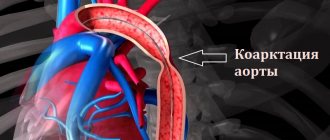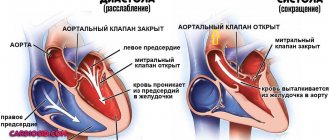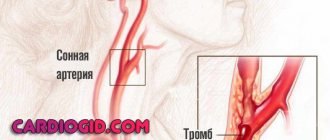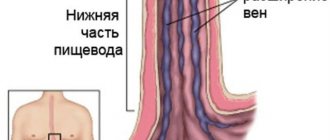Increased blood pressure can otherwise be called arterial hypertension.
Arterial hypertension occurs for a long time without obvious manifestations. However, soon enough it can lead to acute cerebrovascular accidents in the form of TIA (the so-called transient ischemic attack or, in other words, all manifestations of a stroke, but within 24 hours), strokes, as well as to hypertrophy of the walls of the heart and/or enlargement of cavities hearts.
In addition, arterial hypertension is a risk factor for the formation of atherosclerotic plaques in blood vessels and the occurrence of myocardial infarction.
The relationship between blood pressure levels and the risk of cardiovascular disease is linear.
The higher the blood pressure, the greater the likelihood of myocardial infarction, stroke, heart failure and kidney damage.
The prevalence of arterial hypertension (AH) in the Russian Federation is 39.3% among men and 41.1% among women, while blood pressure is properly controlled in only 17.5% of women and 5.7% of men.
Systolic blood pressure increases steadily with age, while diastolic blood pressure rises until age 60 in men and age 70 in women, after which it tends to decrease.
WHAT IS SYSTOLIC DIASTOLIC AND PULSE PRESSURE
Blood pressure is the pressure that blood exerts on the walls of the arteries.
There are:
- systolic pressure
- diastolic pressure
- pulse pressure
Systolic pressure (upper)
This is the maximum pressure in the arterial system developed during contraction of the left ventricle.
It is determined by the volume of blood that the heart pumps out in one contraction, as well as the elasticity of the aorta and large arteries.
Diastolic pressure (lower or heart)
This minimum pressure in the arteries during relaxation of the heart is determined by the amount of tone of the small arterioles.
Pulse pressure
This is the difference between systolic and diastolic blood pressure.
So the reasons for high blood pressure:
Causes
In approximately 90% of cases, the cause of a stable increase in blood pressure is hypertension. This diagnosis is made to the patient when no other diseases accompanied by hypertension are found during the examination. Among the latest:
- kidney pathologies – pyelonephritis, glomerulonephritis, polycystic disease, diabetic nephropathy, renal artery stenosis;
- endocrine disorders - neoplasms of the adrenal glands, pancreas or pituitary gland, hyperfunction of the thyroid gland, Cushing's disease or syndrome, pheochromocytoma;
- obstructive sleep apnea syndrome;
- valve defects or atherosclerotic lesions of the aorta.
Regular use of some medications can also cause high blood pressure.
These include oral contraceptives, non-steroidal anti-inflammatory drugs, amphetamines, corticosteroids, drugs containing erythropoietin, cyclosporine, cocaine. The likelihood of developing cardiovascular diseases, including hypertension, is closely related to the following risk factors:
- unhealthy diet, including excess amounts of table salt, saturated fats and trans fats, lack of leafy greens, vegetables and fruits in the diet;
- obesity;
- pathologies of the heart and blood vessels in close relatives;
- age over 65 years;
- sedentary lifestyle;
- chronic stress;
- bad habits – smoking, excessive alcohol consumption.
Brief conclusions
- The causes of high blood pressure can be either humoral (tension of the vascular walls under the influence of biologically active substances) or neurogenic (hyperactivation of the sympathetic nervous system).
- Blood pressure can rise due to a number of factors, such as stress, tension, overwork, and physical activity.
- High blood pressure can also be caused by a specific disease (example: kidney disease, brain tumors, hypo- and hyperthyroidism, taking corticosteroid hormones).
- In children, high blood pressure often develops under the influence of psycho-emotional stress.
Treatment
With a moderate and low risk of cardiovascular complications, the patient is recommended only to change his or her lifestyle, adjust the diet, lose weight, increase physical activity and special exercises for hypertension, and give up bad habits while regularly measuring blood pressure.
Often these measures are enough to normalize blood pressure. A diet for hypertension involves limiting table salt, caffeine, hot, salty, smoked and spicy foods, high-fat foods, offal, confectionery with butter cream and alcoholic beverages. It is permissible to consume no more than 5 g of salt per day outside of an exacerbation of the disease. The recommended daily fluid intake is 1-1.2 liters.
In case of unsuccessful non-drug treatment for several months, as well as in case of a high risk of complications, they resort to antihypertensive therapy using medications for hypertension, the goal of which is to reduce blood pressure to less than 140/90 mm. Hg Art. For patients with diabetes or people already suffering from pathologies of the cardiovascular system, the target pressure level is even lower - 130/80 mm. Hg Art.
Modern drug treatment of hypertension includes a combination of two or more drugs from the following groups:
- calcium antagonists;
- angiotensin-converting enzyme inhibitors;
- angiotensin II blockers;
- diuretics (diuretics);
- b-blockers;
- alpha-blockers.
The vast majority of them are available in the form of tablets for hypertension.
Danger to organs and body systems
- Heart. Due to the increased load, the walls of the myocardium begin to grow, especially the left ventricle, which works to eject blood. With tissue hypertrophy, nutritional deficiency begins, wear accelerates, and elasticity decreases. As a result, arrhythmia, bradycardia, ischemia, and heart attack may develop.
- Vessels. Constant tension makes blood vessels fragile, deforms them, and leads to ruptures. Hypertension increases atherosclerotic deposits, up to complete blockage. First of all, the capillaries that provide nutrition to the internal organs, eyes, and limbs are affected.
- Brain. Insufficient brain nutrition in hypertension leads to cognitive impairment. The most common cause of strokes is hypertension.
- Kidneys. Lack of blood circulation leads to the accumulation of toxins. The kidneys cannot cope with excretion in full; they do not have enough nutrients to recover. This leads to the development of kidney failure and further worsens the condition of blood vessels, as harmful compounds remain in the blood.
- Eyes. Hypertension can cause damage to the optic nerve, and in the most severe cases, blindness occurs.
Symptoms
Often, an increase in blood pressure is not accompanied by a deterioration in health and may go unnoticed by the patient, which is why it is so important to regularly measure blood pressure, especially for middle-aged and elderly people.
Manifestations of hypertension may include the following symptoms:
- headache, mainly in the morning after waking up;
- nosebleeds;
- hemorrhage under the mucous membrane of the eye;
- heart rhythm disturbance;
- blurred vision, flickering spots;
- tinnitus.
A sharp jump in blood pressure to high numbers, accompanied by a pronounced deterioration in well-being, is called a hypertensive crisis. Most often it occurs when systolic pressure rises to more than 180 mm Hg. Art. and/or diastolic over 120 mm Hg. Art. In this case, the patient experiences weakness, nausea, vomiting that does not bring relief, impaired consciousness, anxiety and fear, muscle tremors, and chest pain.
Borderline level of hypertension
There is another name for borderline hypertension - labile. The increase in pressure in this case is unstable, its readings vary from normal to borderline elevated. Irreversible disorders do not occur in the labile form of hypertension, there are usually no symptoms, such an increase in pressure does not affect the state of health, it always normalizes on its own, so there is no need to resort to medications. However, people with borderline hypertension are always at risk of developing overt hypertension at some point. Therefore, monitoring blood pressure in this situation will not be superfluous. This is especially true for people who are over 30 years old, as well as those who are overweight or have poor heredity.
Borderline hypertension is most often temporary and can be observed in the following cases:
- during menopause in women;
- in athletes, under excessive loads;
- with alcohol intoxication;
- nervous disorders, in stressful situations;
- during puberty in adolescence.
In case of low blood pressure we speak of hypotension. The tonometer readings for hypotension are as follows: 90 to 60 and below. Low blood pressure also causes a lot of trouble. A person in this state feels weakness, drowsiness, chronic fatigue, dizziness, his skin turns pale, and his limbs are constantly cold. Hypotonic people are usually people of asthenic physique.
The danger of hypotension is poor blood saturation of the entire body and, as a result, a hypotonic crisis (the pulse weakens, breathing becomes difficult, loss of consciousness, bleeding of the skin and limbs is possible). In such a situation, it is necessary to increase the level of pressure as quickly as possible, for this there are special medications, at home a cup of strong coffee or tea, a contrast shower, a stimulating massage will help, various herbal tinctures (eleutherococcus, ginseng, echinacea) are effective.
Classification
If it is possible to identify a disease that leads to an increase in blood pressure, arterial hypertension is called secondary or symptomatic.
When the cause is unknown, hypertension is considered to be primary hypertension. The latter has a staged course:
- Stage I. There are no obvious signs of disruption of the target organs affected by a stable increase in blood pressure - the heart, kidneys, arterial and venous vessels.
- Stage II. One of the listed signs or a combination of them is present, such as an enlargement of the left ventricle of the heart, a marked decrease in the filtration rate in the kidneys, albumin in the urine, an increase in the thickness of the walls of the carotid arteries or the appearance of atherosclerotic plaques in their lumen. In this case, clinical manifestations of the disease may be absent.
- Stage III hypertension. There is one or more pathologies associated with atherosclerotic processes in the heart and blood vessels - myocardial infarction, acute cerebrovascular accident, angina pectoris, atherosclerosis of the arteries of the lower extremities, or serious kidney damage, manifested by a pronounced decrease in filtration and/or significant loss of protein in the urine.
Arterial hypertension is divided into several degrees depending on the maximum measured blood pressure:
- First degree. Systolic blood pressure is from 140 to 159 mm. Hg Art. and/or diastolic – from 90 to 99 mm. Hg Art.
- Second degree. Systolic blood pressure from 160 to 179 mm. Hg Art. and/or diastolic – from 100 to 109 mm. Hg Art.
- Third degree. Systolic blood pressure is more than 180 mm. Hg Art. and/or diastolic over 110 mm. Hg Art.
There is also an isolated form of arterial hypertension, in which only the systolic pressure numbers are increased while the diastolic pressure is normal.
How to Prevent the Dangers of High Blood Pressure
When diagnosed with hypertension, a full examination is required to find the cause due to which the pathology develops. At the same time, it is important to stabilize indicators in order to reduce the risks of developing a crisis and complications.
- You need to measure your blood pressure several times a day, preferably at the same time. It is better to record the data and take it to a doctor’s appointment - this will allow you to track the dynamics and identify patterns.
- Under no circumstances should you stop taking prescribed medications on your own. If persistent improvement occurs during therapy, patients often stop taking medications. You can't do this. Cancellation, reduction of dosages, replacement of one drug with another is carried out only under the supervision of a doctor.
- It is necessary to adhere to a daily routine and avoid overwork. It is easier for the body when the usual rhythm is not disturbed.
- At the first sign of deterioration, seek help. Fluctuations in indicators and progression of hypertension can cause a crisis, heart attack, or stroke, so any changes should be reported to the doctor to adjust therapy or conduct additional examination.
Since hypertension affects all organs and systems, regular restorative and supportive courses are recommended for blood vessels, heart, and other organs as indicated.
Atypical manifestations
Sometimes hypertension manifests itself atypically; it can be difficult to suspect it in the presence of such uncharacteristic symptoms, especially for an ordinary person who does not have a medical education. Symptoms that are not typical for high blood pressure:
- visual acuity is impaired;
- kidney problems (frequent urination at night, urine analysis reveals protein, red blood cells, white blood cells);
- erectile dysfunction in men;
- menstrual irregularities in women.
Diagnostics
The main sign of hypertension is a stable increase in blood pressure, detected in at least three measurements on different days in a calm environment. When measuring blood pressure for the first time in a hospital or clinic, to ensure the correctness of the results obtained, it is important to follow the following rules:
- Before the examination, the patient needs to sit for a few minutes in a quiet room to calm down;
- the size of the tonometer cuff must correspond to the thickness of the arm, and the device itself must be mounted at the level of the heart;
- two measurements are performed with an interval of 1-2 minutes on each hand; if there is a large difference in the obtained figures, an additional measurement is taken;
- in elderly patients, as well as people suffering from diabetes mellitus, or if a decrease in blood pressure is suspected in case of a change in body position, measurements are taken in the first and fifth minutes in a standing position;
- Additionally, heart rate is measured for 30 seconds.
The doctor, in a conversation with the patient, clarifies at what age the pressure first began to increase, whether there are any symptoms such as snoring with pauses in breathing during sleep, attacks of muscle weakness or sudden heartbeat with sweating and headache, and unusual impurities in the urine.
It is also important to find out what medications and dietary supplements he is taking. As part of the first stage of examination for hypertension, the following tests are performed:
- clinical blood test;
- general urine analysis, detection of microalbumin in its single and daily portions;
- biochemical blood test (cholesterol, lipoprotein levels to assess the risk of atherosclerosis, blood electrolytes - potassium, sodium, chlorine, calcium, as well as glucose and creatinine);
- determination of the level of glycated hemoglobin;
- determination of the concentration of hormones - thyroxine, triiodothyronine and thyroid-stimulating hormone, antibodies to thyroid peroxidase and thyroglobulin, aldosterone.
If a hereditary predisposition to the disease is suspected, it is possible to determine polymorphisms of genes associated with the development of arterial hypertension.
In order to clarify risk factors for the development and identify existing cardiovascular pathologies in hypertension, instrumental diagnostic methods are used:
- 24-hour blood pressure monitoring;
- electrocardiographic study;
- echocardiography;
- 24-hour Holter monitoring;
- duplex scanning of the brachiocephalic, renal or iliofemoral arteries;
- ultrasound examination of the kidneys and adrenal glands;
- fundus examination.
For hypertension, it is important to monitor blood pressure at home by keeping a diary, in which it is necessary to record all the results of measurements over time, medications taken and episodes of stress that can provoke a rise in blood pressure. In this case, measurements must be taken in a sitting position, after several minutes of rest, keeping your hand at the same level as your heart.









